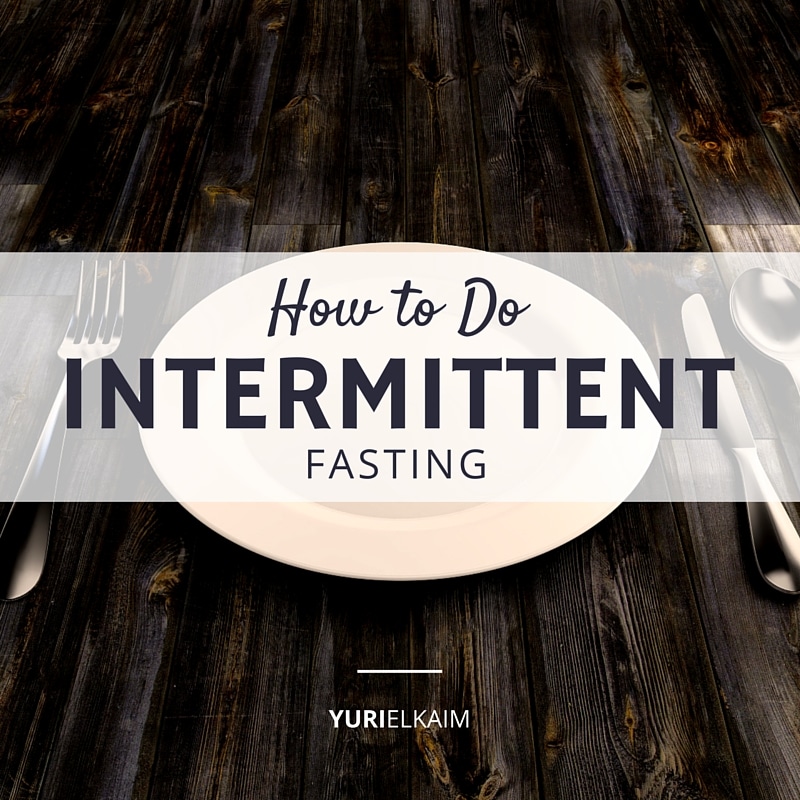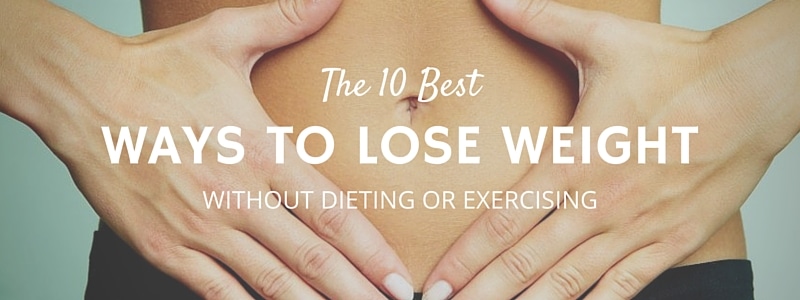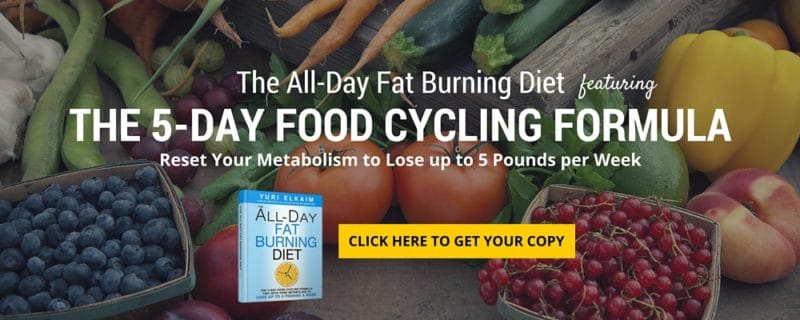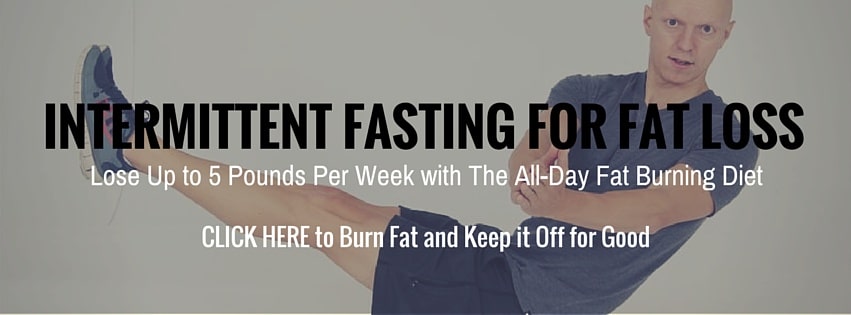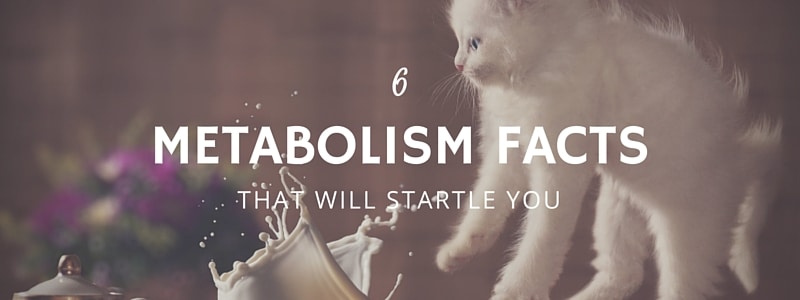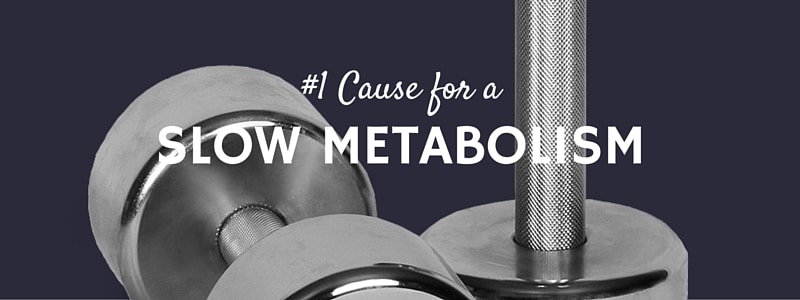In this article
If you’ve been wondering how to implement intermittent fasting or any other protocol to fast one day a week, I’m going to provide you with the ultimate primer on this amazing dietary practice.
You see, intermittent fasting is arguably the least expensive and most powerful healing method we can incorporate into our lives.
Every religion has an element of fasting—whether it’s 30 days of Ramadan or a one day Yum Kippur fast. Our ancient ancestors were definitely on to something.
We humans have been fasting since we first walked the earth. Our paleolithic ancestors didn’t have the luxury of 24/7 convenience stores, a Starbucks on every corner, or even refrigerators to store their food.
Thus, they ate what was freshly available.
But sometimes they couldn’t find anything to eat, and their bodies evolved to be able to function without food for extended periods of time. Today, we still have this same biology – we haven’t evolved at all.
And, if anything, fasting from time to time is more “natural” and healthier than constantly eating 3-4 (or more) meals per day. I’ll show you proof further below.
For years, my clients and readers have asked me which is better for weight loss; eating 3-5 meals per day or intermittent fasting, not to mention they also wanted to know how to do it.
So in this post, I’m going to answer 18 of the most common fasting questions I’ve been asked in order to give you a solid understanding of the topic.
Let’s jump in…
What You Need to Know About Intermittent Fasting
1. What is Intermittent Fasting?
It is an eating pattern where you cycle between periods of eating and not eating. It’s not a diet that says “eat this, not that”, but rather you don’t eat any food for a certain length of time – usually 16-24 hours.
There are a number of different types of intermittent fasting (highlighted below), but they all serve the same purpose—to allow your body time without food to spend more of its energy on internal healing and repair—something that cannot happen when you’re constantly in a fed state.
2. Who is Intermittent Fasting For?
Based on the numerous benefits you’re about to discover, intermittent fasting is really meant for anyone who is serious about improving their health and perhaps losing weight without overhauling their diet.
[Related: 10 Ways to Lose Weight Fast Without Dieting or Exercising]
Technically, you don’t need to change anything about your diet to benefit from intermittent fasting, which makes it very appealing to many people.
It’s also for those who want that extra edge to burning fat while maintaining their muscle (shouldn’t we all?).
It’s completely safe to do and provides enormous benefits so it’s really just a matter of committing to it, trying it out, and seeing if it’s something you want to do regularly.
3. What Are Some of Its Benefits?
There are literally dozens of benefits! If you’re wondering how to do intermittent fasting to get the most bang for your buck, check out some of these incredible benefits – all backed by science:
Increased Life Expectancy:
Studies on animals are being done by Dr. Mark Mattson and colleagues at the National Institute on Aging. The findings from these studies suggest that animals age slower and live longer when they consume fewer calories. The research is showing that this effect can be achieved by eating less each day, or by fasting on intermittent days. (1)
[Related: Living Longer: The Okinawan Secret to a Long, Lean Life]
Improved Hormone Profile:
When fasted, we get significant reductions in blood sugar and insulin levels, as well as a drastic increase in human growth hormone (2,3). These all favorable for losing weight, maintaining muscle, and reducing our risk of insulin resistance, diabetes, and heart disease.
Faster Weight Loss:
Most people want to know how to do intermittent fasting because they’ve heard it’s a safe and effective way for losing weight. And they would be correct.
Many studies have shown that both overweight and obese subjects burn more fat and lose weight with intermittent fasting (4,5).
Here are a number of other documented benefits of intermittent fasting:
- Maintenance of skeletal muscle mass
- Decreased blood glucose levels
- Decreased insulin levels and increased insulin sensitivity
- Increased lipolysis (breakdown of fats) and fat oxidation
- Increased uncoupling protein-3 mRNA(important for the production of energy inside the cell)
- Increased norepinephrine and epinephrine levels, which increases fat breakdown
- Increased glucagon levels, which breaks down fat
- Increased growth hormone levels, which preserves muscle mass
4. Why is It Effective?
A 2014 review of the literature showed intermittent fasting’s powers come from its impact on adaptive cellular responses that reduce oxidative damage and inflammation, optimize energy metabolism, and improve cellular production.
The review showed that in rodents, intermittent fasting was able to protect against diabetes, cancers, heart disease and neurodegeneration, while in humans it helps reduce obesity, hypertension, asthma, and rheumatoid arthritis. (6)
An earlier study conducted in 2005 published in the Journal of Nutritional Biochemistry revealed that the beneficial effects of intermittent fasting result from at least two mechanisms: reduced oxidative damage and increased cellular stress resistance. (7)
Basically, that means that it helps your body deal with stress, which includes being able to better cope with fasting (which is a form of stress) itself.
Fasting also triggers the process of autophagy, which breaks down and recycles dysfunctional proteins and cellular debris. (8)
This is similar to taking out the trash and cleaning up around the house – a process you’d hope would be taking place in your body on a frequent basis.
Hopefully, this gives you a better understanding of how intermittent works its magic inside your body.
5. Why Does Intermittent Fasting Burn Fat?
Earlier, I mentioned a number of benefits of intermittent fasting, many of which centered around fat loss.
Here’s a recap, plus a few more mechanisms through which fasting increases “lipolysis” (fat burning) in the body:
- Increased uncoupling protein-3 mRNA(important for the production of energy inside the cell)
- Increased norepinephrine and epinephrine levels, which increases fat breakdown
- Increased glucagon levels, which breaks down fat
- Increased growth hormone levels, which preserves muscle mass and thus a healthy metabolic rate which in turn burns more fat
- Increased activation of hormone sensitive lipase
Let’s take things up one level from the technical sciency stuff.
Basically, not eating tells your body to rely more heavily on its fat stores. This is a similar phenomenon experienced with consistent exercise training.
Basically, your body becomes “smarter” and understands that, in order to maintain blood sugar and spare muscle and liver glycogen (stored carbohydrates) for potential immediate use, it’s better off relying on fat, which naturally provides more energy (9 calories per gram) versus carbohydrates or protein (4 calories per gram each).
6. Which Type of Intermittent Fasting is Best?
Here, I’ll explain how to do it through three different methods and I’ll tell you which one I employ on a weekly basis in addition to being a prominent feature in The All-Day Fat Burning Diet.
Alternate Day Intermittent Fasting:
Alternate day intermittent fasting is basically fasting every other day for a 24-hour period. For instance, you would eat normally on Monday, fast Tuesday, eat Wednesday, fast Thursday, eat Friday, fast Saturday, and so on.
This style of intermittent fasting is the most popular form used in research studies, but from what I have seen it isn’t very popular in the real world. I’ve never tried alternate day fasting myself and I don’t plan to do so.
In my eyes, it’s a bit excessive and many of the negative effects seen in some women while fasting tend to be related to this type of fasting.
And it makes sense since you’re not eating half the time, which is not advisable, especially for women for whom carbs and caloric intake are important for hormones and fertility.
If this is the first method you try as you figure out how to do intermittent fasting, my fear is that it will be too difficult for you and you’ll give it up altogether.
The truth is, it’s just not sustainable for most people unless you enjoy feeling miserable 50% of your life. As a result, I think you’re better off using either (or a combination) of the following two intermittent fasting methods.
16/8 Daily Fasting:
This type of intermittent fasting was popularized by Martin Berkhan from Leangains.com and has worked really well for him and thousands of his followers.
Basically, you fast for 16 hours and eat during the remaining 8.
His general position on the fasted phase is that it should last through the night and during the morning hours. Ideally, the fast should then be broken at noon or shortly thereafter if you wake up at 6-7 AM like most people. Afternoons and evenings are usually spent in the fed state.
To be quite honest, even though I only do a committed fast once per week, I probably do 16/8 fast – inadvertently – 2-3 times per week mostly because I don’t feel like eating anything until about lunch time.
It doesn’t matter when you start your 8-hour eating period. You can start at 8am and stop at 4pm. Or you start at 2pm and stop at 10pm. Do whatever works for you. Based on my schedule, I tend to eat around 1pm and 5pm most days.
The 1-Day Fast:
Go here for the specific plan to follow.
As the name implies, this is a 1-day fast – typically 18-24 hours in length.
I initially learned about it from my good buddy, Brad Pilon, and have adopted it ever since. It’s also the type of intermittent fasting that I recommend in The All-Day Fat Burning Diet.
Here, instead of fasting every day or every other day, you simply fast once per week. I’ve found this to be most realistic and sustainable for most people.
To make it easy on yourself, simply start your fast after dinner so that by the time you wake up the next morning you’ve already completed about 12 hours of your fast. Then, if you can make it on water and/or herbal tea until mid-afternoon or early evening, you’re golden.
Having coached thousands of people through this process, let me say that being hard on yourself for not making it the full 24 hours is not a good idea.
Don’t beat yourself up. If you’ve fasted 14, 17, 20, or however many hours, just be happy with the fact that you’ve given your body a “breather” to do some much needed cleansing and healing.
[Related: 7 Cleansing Green Juice Recipes Made Without Fruit]
Please remember as well that your first 1-day fast will likely be a challenge, especially if you’re used to eating all the time. However, it will also be one of the most rewarding experiences you go through as you’ll a lot about why you eat.
A lot of times you’ll recognize that you’re not hungry but rather anxious, bored, or in a “conditioned” situation (like working at your desk) where you would normally be snacking on food. This awareness alone is worth doing a 1-day fast.
Whichever type of intermittent fasting you choose, the additional benefit it provides you is a little more flexibility with your diet.
You don’t need to be a food nazi and nit pick every single thing you eat as a weekly fast can help clean up some of the junk. But also don’t use that as a hall pass to eat whatever you want at your other meals throughout the week.
7. How to do Intermittent Fasting — Where to Begin
Whether you’re a man or woman, the benefits of fasting are simply too numerous to ignore. So how do you get started? Well, here’s an excerpt from my book The All-Day Fat Burning Diet, in which a 1-day fast plays a prominent role in helping you get and stay lean.
I’m very aware that the mere mention of the term fasting terrifies many people, conjuring up images of intense suffering and starvation. They picture themselves waking up in the morning and starting their 24-hour timer, anxiously counting down the milliseconds until they can have the first bite of their post-fast meal. Others can’t even fathom the idea of going a full day without food.
It really doesn’t have to be so awful, and there’s an approach that actually makes it quite doable. In fact, it’s what I do. It’s a bit of a cheat, but it doesn’t lessen the benefits of your fast, so I say give it a go. The day before your 1-Day Fast is your 1-Day Feast. On that day, about 3 hours after you’ve enjoyed the last bite of your last meal for the day, start the timer on your 1-Day Fast.
For example, if you had a big dinner around 7 p.m., your body would be in a “semi-fasted” state by the time 10 p.m. rolls around. Consider that the kickoff of your fast. Hit the sack and sleep for 7 to 8 hours. By the time you wake up, you’ve completed one-third of your day’s fast without batting an eyelash, literally.
If you’re anything like me, you might not feel hungry in the morning. There’s a good chance this will happen considering how much you stuffed yourself the day before. So much for breakfast. If you can make it to lunch on a few glasses of water, then you’ve just knocked out 14 hours of your fast.
And if you can make it to at least 4 p.m., that’s 18 hours. You’re really on fire at this point. Maybe you can have a cup of peppermint tea as a reward. After all, this is when the massive health benefits from your short-term fast really start to kick in.
At this point, if you really can’t take it, you can have a smoothie or smaller meal to break your fast. However, if you really want to win, power through to dinner without taking a bite. Once you reach 10 p.m., you’ve made it. You’ve successfully completed your fast and you can go to bed dreaming about breakfast.
If you can’t wait until morning to eat, I recommend a small high-protein meal or, better yet, a protein shake with a few carbs about an hour before you go to sleep. That way, you provide essential proteins to your muscles, while keeping your tummy satisfied until morning. The 1-Day Fast isn’t easy, but it’s not impossible either, and when you stay focused on the benefits, it becomes a lot more doable. Can you do this? I bet you can.
What makes it all a whole lot easier is simply making the decision to do it. Most people have a tough time without food because they’re constantly thinking about what they’ll eat next. In the middle of a stressful day, that just feels like too much to handle, as the satisfaction that comes from a delicious meal—even one that’s not good for you— helps people soothe their blues away. When that food isn’t there, they start panicking.
When you consciously make the decision that tomorrow will be a fast day, you activate a new mechanism inside yourself. You’re forced to let your innards recharge while you reflect on the bad eating habits with which you’ve been self-medicating. Fasting is such a profound tool for deep change. No wonder people have been turning to it for centuries.”
There you go. That’s all you need to start intermittent fasting.
8. How to Do Intermittent Fasting for Weight Loss?
Similar to what I described above, the easiest way to do intermittent fasting for weight loss is to simply do it just once per week.
Although a lot of the research on fasting has used “alternate day” fasting where you basically don’t eat every other day (which is crazy if you ask me), you can still see noticeable fat loss results with just a single day of fasting each week.
So finish dinner and start your fast thereafter. Then, if you can make it through to the next day’s dinner you’re golden. Remember, when your body is in a fasted state is starts to rely more on its fat stores for fuel.
Thus, it helps you become a fat burner instead of sugar burner who is constantly craving food. It’s a very freeing process.
Here’s another strategy you can use to speed your weight loss while intermittent fasting:
At any point of your day, do 5-10 minutes of high intensity interval training to increase your body’s release of catecholamines. These are your fight- or-flight hormones—specifically, epinephrine and norepinephrine—released by the adrenal glands in response to stress like high intensity training.
One of the roles of these hormones is to break down stored fat in your body into free fatty acids that can then be converted into energy. This intense exercise also depletes your glycogen stores much more readily.
As glycogen is depleted, your body must rely further on burning fat for energy.
You do not get this catecholamine response with low-intensity exercise. (If the word intensity scares you, don’t be alarmed. You’ll only be doing 5 to 10-second bouts interspersed with nice and easy recovery.)
And if you want to take your fat burning to the next level, then after you finish your intervals, spend 30 minutes or more going for a nice easy walk or bike ride to burn up those free fatty acids (from broken-down fat) that have flooded into your bloodstream.
Post-workout is when your body, since it’s recovering, really relies on those fats for fuel.
For instance, a 2008 study showed that even though carbohydrates were the predominant fuel source during the actual workout, for more than 3 hours afterwards, fats became the main contributor to energy. (9)
Basically, the most fat was burned post-workout. But again, workout intensity sets the stage for this to happen.
So, to really take advantage of this fat-burning window, I strongly recommend following your high intensity intervals with 30 minutes (or more) of low-intensity cardio like walking.
This will help shuttle those free fatty acids floating around in your bloodstream into your muscles to be burned as fuel.
9. What Should I Eat After My Intermittent Fast?
One of the most important steps in learning how to intermittent fast is figuring out how to ease back into eating.
When you finish your fast you need to pretend that your fast never happened. No compensation, no reward, no special way of eating, and no all-out binges.
The minute you decide to stop fasting, simply wipe the fast from your memory, and eat the exact way you would normally eat at that specific time of the day (while eating responsibly of course).
If you end your fast at dinnertime, have dinner. If you end your fast at 4:00 PM and you don’t typically have dinner until 6:00 or 7:00 PM, then have a light snack… but nothing larger than you would normally have at that time.
There is no magic way to end your fast. The absolute best thing you can do is simply pretend your fast never happened and begin eating in the exact way you would normally eat at that specific time of day.
One thing I have noticed though with many clients is that they tend to “crave” healthier foods at the end of their fast.
As a result, they end up choosing a green smoothie or a healthy snack instead of devouring a large pizza (as you might think would happen after not eating anything all day).
10. Is Intermittent Fasting Bad for My Blood Sugar?
The truth about having low blood sugar is that it is not nearly as common as we are often led to believe. But obviously check with your doctor if you’re uncertain.
For the vast majority of the healthy population, we are easily able to maintain healthy blood sugars that are neither too-high nor too-low in a whole range of different situations, including fasting and intense exercise.
In research examining the effects of a 24 hour fast, it was found that fasting did not cause blood sugar levels to dip below 3.5 mmol/Liter, meaning that during the entire 24 fast, blood sugar slowly lowered itself, but remained at normal non-hypoglycemic levels. (10)
11. Can I Exercise When Intermittent Fasting?
I absolutely encourage you to practice as many different types of exercise as possible. Just like nutrition, I think variety is the key to exercise and both yoga and mountain biking are excellent examples of exercises that complement intermittent fasting.
As long as you are doing some form of resistance training at least two or three times a week you will not lose muscle since intermittent fasting actually increases growth hormone, which helps preserve muscle.
One thing you may notice is if you work out on day in which you’re fasting, your energy levels may be a little lower.
That’s because the workout will be tapping into lowered glycogen reserves, which means you may fatigue sooner than on a traditional “eating” day.
However, exercising, especially for short durations at high intensity, in a fasted state is a secret weapon I would strongly encourage you to explore as it will accelerate fat loss tremendously (more on that below).
12. Why Do I Get Hungry When Intermittent Fasting?
Well, you’re not eating any food so naturally your stomach might experience the odd growl here and there.
Additionally, your hunger hormone ghrelin responds to a lack of food in the stomach, which will naturally have it firing on all cylinders, making your brain think you’re starving.
Hunger pangs usually dissipate after your first 2-3 fasts as your body adjusts.
13. Why Do I Get a Headache When Intermittent Fasting?
First of all, not everyone does.
But there has been a lot of research on Ramadan fasting and headaches. (11,12) It seems that women are particularly susceptible to headaches while fasting.
This is not due to dehydration and may actually be similar to withdrawal symptoms, similar to the headaches you experience when you quit drinking coffee cold-turkey.
From my experience, if you experience headaches they do tend to go away after your first couple of fasts.
If needed, you can treat your headache as you normally would when not fasting. Just remember to drink lots of water and get some fresh air during your fast (and in general).
14. Can I Drink When Intermittent Fasting?
Yes you can but make sure there are no calories.
That also doesn’t mean drinking diet soda is ok, because it’s not. Just drink water or herbal tea.
Some people tell you that black coffee is ok to drink during a fast but I wouldn’t advise that. Yes, the caffeine in the coffee will skyrocket your epinephrine which can assist with fat loss, but since I don’t advise drinking coffee in general, you’re better off without it, especially when its caffeine isn’t buffered by food.
[Related: Controversial Exercise Advice That Speeds Fat Loss]
Instead, focus on drinking plenty of water and/or any herbal teas that you enjoy without the use of milk, sugar, or sweeteners. Remember, this is a day of “rest” for your body so that means no calories of any kind.
15. Can I Still Take My Supplements When Intermittent Fasting?
You can but I would give your body a break for the day. So if you’re taking multivitamins, fish oil, probiotics, etc… just take a day off from supplementation.
This may also help prevent your body from developing sensitivities to commonly consumed supplements and ingredients that can occur with continued consumption of literally any food product.
16. How Often Should I Do Intermittent Fasting?
This really depends on the type you’re using but if you’re following my 1-day fast, then once per week is plenty. Some people choose to do TWO 24-hour fasts per week and have seen great results doing so, but I would say that’s the maximum.
17. Why Do I Get Cold When Intermittent Fasting?
Fasting increases the blood flow to your body fat (the process is called adipose tissue blood flow). (13)
So when you are fasting, more blood is travelling to your body fat, presumably to help move it to your muscles where it can be burned as a fuel. Due to this increased travel to your body fat, vasoconstricton occurs in your fingertips and sometimes toes to compensate.
18. Will Intermittent Fasting Slow Down My Metabolism?
In spite of all the fat burning benefits I’ve already mentioned, you might still be wondering whether or not intermittent fasting will slow your metabolism to a halt.
After all, you’ve probably been told that you have to eat every 2-3 hours or your metabolism will shut down and you’ll store fat. Thankfully, that couldn’t be more untrue.
[Related: 6 Startling Facts about Your Metabolism]
In a 2000 study published in the American Journal of Clinical Nutrition, subjects went through 4 days of fasting to determine the impact on their resting energy expenditure, which is the amount of energy your body needs to carry out all of its basic functions when you’re resting.
The findings would surprise most people: for the first 3 days, the subjects all saw their resting energy expenditure (metabolism) increase! (14)
In another study by a different group of researchers, people who even fasted every other day (alternate day fasting) for 22 days had no decrease in their resting metabolic rate.
In addition, people who were on very-low-calorie diets and on a resistance exercise program (i.e., lifting weights) did not see a decrease in resting metabolic rate, and these people were eating only 800 calories a day for 12 weeks! (15)
In still more studies, there was no change in the metabolic rate of people who skipped breakfast, or people who ate two meals a day compared to seven meals per day. (16)
The bottom line is that food, or the lack thereof (at least in the short term), has virtually nothing to do with your metabolism.
In fact, your metabolism is much more closely tied to your body weight, and specifically your muscle mass. If your body fat (and thus your lean mass) goes up or down, so does your metabolism.
[Related: The #1 Cause of a Slow Metabolism]
Bringing a few of these studies to your attention has hopefully shown you that short-term fasting can provide incredible benefits without worrying about it sabotaging your metabolism.
There’s nothing to be scared of, and hopefully, I’ve eased any misconceptions you’ve had about intermittent fasting and its impact on your metabolism.
19. Is Intermittent Fasting Safe for Women?
Ah, I’ve saved the best for last.
This is the biggest area of controversy when it comes t0 intermittent fasting.
Those who caution women against intermittent fasting state that studies show that it negatively impacts fertility. And that’s true.
Unfortunately, what most of these people fail to realize is that ALL of these studies use “alternate day” fasting protocols where women are literally eating nothing every other day!
No wonder their hormones get messed up and have fertility issues.
Remember, I’m advising a 1-day fast – once per week – which is much, much safer and I’ve yet to see any negative effects in the thousands of women that I’ve helped with intermittent fasting.
There is some research that looked at the effect of short-term fasting on the menstrual cycle of women.
These research studies found that despite the metabolic changes that occur during fasting, even fasts as long as 72 hours do not seem to have an effect on the menstrual cycle of normal cycling women. (17)
Interestingly, even longer fasts have been shown to have little impact on the menstrual cycle of normal weight women.
There is research, however, to suggest that longer fasts (72 hours) can affect the menstrual cycle of exceptionally lean women (body fat levels well below 20%). (18, 19)
Overall, there’s a lot of research (even some of the “alternate day” studies) that show intermittent fasting to be safe, healthy, and effective at burning fat in women of all shapes and sizes (20, 21, 22, 23, 24).
But again, we’re not going crazy with this and only fasting for no longer than 24 hours.
Nonetheless, if you’re a woman and still unsure whether or not intermittent fasting is right for you, then my advice would be to inch yourself into it so that you’re fasting for 8-10 hours at a time. Then gradually increase that length of time as you see fit.
Updated FAQ:
What is your opinion on intermittent fasting if a person has hypothyroid?
In general you should be fine if your fast is no longer than 24 hours. Here’s what you should know: since the circadian rhythm is affected by both food and light exposure, lifestyle practices can enhance natural circadian rhythms. These practices should optimize the circadian cycle:
Light entrainment: Get daytime sun exposure, and sleep in a totally darkened room.
Daytime feeding: Eat during daylight hours, so that food rhythms and light rhythms are in synch.
Intermittent fasting: Concentrate food intake during an 8-hour window during daylight hours, preferably the afternoon. A 16-hour fast leading to lower blood sugar and insulin levels, and the more intense hormonal response to food that results from concentration of daily calories into a short 8-hour time window, will accentuate the diurnal rhythm.
Adequate carb intake: this will be taken care of on other days where you’re eating plenty of healthy carbs.
I’ve read that fasting not a good idea if you have adrenal fatigue. What are your thoughts?
It will depend on the individual but if you’ve got full blown AF you may want to do a shorter fast and have something small throughout the day to stabilize your blood sugar.
If you’re interested in how to do intermittent fasting in a safe and sustainable manner, then this is what I’d recommend you do…

